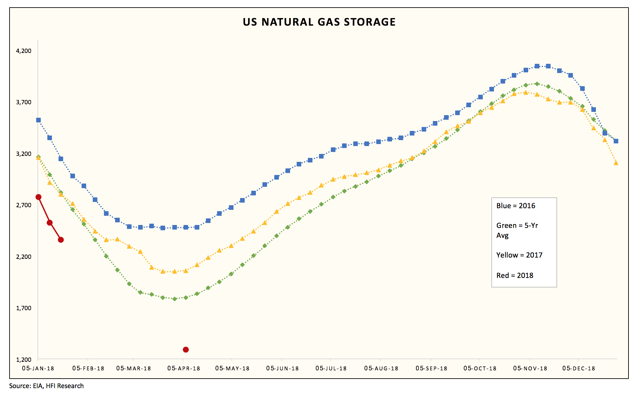周四 ,五, 天然氣來了一個迅速下跌, 從高點到低點之差接近10%, 這種動蕩是快速交易的良機。
這個sell off 據說是因為市場認為從元月中旬氣溫會回升, 加上庫存報告數字稍微利空。
天然氣現在何去何從?考慮到幾個不同因素分別說說:
1.天氣:
昨天, 今天 東北部很多地方是創紀錄的低溫天氣, 由於上周末的暴風雪, 天然氣用量也創了新紀錄,新年當天 估計天然氣用量 達到150附近, 比原先估計(143)提高。中部本周初會有一短暫的氣溫回升和降水, 雨雪天氣, 但後半周依然很冷,一周後氣問有所回升, 也僅僅是 從超低溫回升接近正常一些而已。氣溫仍低於平均。
2.庫存:
上周4天然氣庫存報告,下降稍少於預期量,這也是sell off的一個理由。 這周天然氣庫存預期下降335, 下周227, 這些數字遠遠超出5年平均水平。可以預見的的是, 這個長達大約三周的超低溫天氣, 對天然氣的供需平衡的影響絕對不能低估。從下麵的圖看。 到這個冬季結束, 天然氣庫存可能降低都1300 左右, 會大大低於5年平均水平, 甚至低於5年最低水平。
3. 產量,
最近幾天有不少因為低溫引起天然氣停產(凍住了)和天然氣管道故障的報道。天然氣產量近幾個月成上升趨勢, 但不可忽視的是需求量也是創紀錄 的增長。加上出口增長, 基本可以抵消增產。
4. 價格:
現在天然氣價格仍在曆史低潮期間, 而天然氣庫存量卻要降低到過低5年最低水平,這顯然是不合理的。
5. 其他:
由於過冷, 東北一些地區天然氣管道運輸出現故障, 天然氣價格過去幾天大幅暴漲,一些地區漲幅高達60倍,這說明天然氣基礎設施是落後的, 不適和應急需要的,也提示資本主義的邪惡性。
上周四ETR公司由於線路故障關閉了一座核電站,一旦關閉, 重開時間難以估計, 公司說要趁機檢修維護。所缺電力 由替代石化電廠補充。
過去兩周, 天然氣CFTC淨多倉有所增加, 但幅度不大。美國從加拿大進口的天然氣可能會減少, 加拿大過冷, 很多地區天然氣飛漲。
綜合技術因素, 我認為天然氣將迅速反彈, 未來幾個月牛市趨勢不會改變,至少沒有大跌的可能性。
美國下一個經濟熱點應該是基礎設施建設!
| Natural Gas | Electricity | Spark Spread |
|||
|---|---|---|---|---|---|
| Region | $/million Btu | % chg* | $/MWh | % chg* | $/MWh |
| New England | 82.75 | +127.8 | 247.03 | +45.3 | 0.00 |
| Mid-Atlantic | 96.07 | +106.5 | 262.24 | +58.7 | 0.00 |
| Midwest | 6.47 | +0.5 | 110.14 | +14.6 | 64.86 |
| Southwest | 3.01 | -49.8 | 30.00 | -34.4 | 8.92 |
| Northwest | 2.88 | -17.7 | 22.75 | -26.6 | 2.59 |
( 注意看此圖:這周天然氣庫存會降至2800 附近, 到4月初季節性低點, 可能達到1300 附近或者更低。)
https://www.investing.com/analysis/natural-gas-got-bomb-cyclone-in-the-new-year-200278125?
https://www.eia.gov/todayinenergy/detail.php?id=34412
Cold weather, higher exports result in record natural gas demand

Estimated U.S. natural gas demand on January 1, 2018 reached 150.7 billion cubic feet, surpassing the previous single-day record set in 2014, according to estimates from PointLogic. Much colder-than-normal temperaturesacross much of the United States have led to increased demand for heating, much of which is provided by natural gas. Although residential and commercial natural gas consumption did not appear to surpass previous records, higher consumption in the electric power and industrial sectors, greater exports of natural gas to Mexico, and more demand for liquefied natural gas (LNG) feedstock gas contributed to the recent record demand level.

Note: Other consumption includes lease and plant fuel consumption, pipeline and distribution use, and vehicle fuel.
Natural gas consumption is typically highest in the winter months, when residential and commercial demand for heating fuels increases. Industrial sector consumption of natural gas is relatively less seasonal but is also higher in winter months. Although the electric power sector consumes the most natural gas during summer months, when overall electricity demand is highest, power sector consumption of natural gas can also increase in winter months. Many homes and commercial buildings use electricity either as their primary or secondary heating fuel, and overall increases in electricity demand are often met by natural gas-fired generators.
This past week, increases in demand led to higher prices in natural gas and electricity markets. Day-ahead natural gas prices for delivery for January 1, 2018, neared $30 per million British thermal units at trading locations in the Mid-Atlantic region, New York, and Boston, according to Natural Gas Intelligence. Because the spot price of natural gas affects power prices in many parts of the United States, spot wholesale electricity prices also rose, surpassing $200 per megawatthour (MWh) in New York City and $185/MWh in New England, according to data from SNL Energy.
Record demand levels are likely to lead to high withdrawals of natural gas from storage fields. EIA’s Weekly Natural Gas Storage Report (WNGSR) showed that in the Lower 48 states, natural gas storage levels as of Friday, December 29, were 3,126 billion cubic feet (Bcf), or about 6% lower than both the previous five-year average (2012–2016) and year-ago levels. In the East region, which covers the Atlantic Coast and some Midwestern states, inventory levels were 740 Bcf, equal to previous year levels and about 5% lower than the previous five-year average. Inventory changes for the week ending January 5 will be released Thursday, January 11.
Generally, changes in natural gas storage are correlated with changes in temperature. Heating degree days represent temperature deviations below 65 degrees Fahrenheit and are weighted based on population distributions across the country. During the previous record withdrawal for the week ending January 9, 2014, U.S. population-weighted heating degree days reached 255. In that week, 288 billion cubic feet of natural gas were withdrawn from storage. For the week ending January 5, 2018, heating degree days are forecast to reach 281.

In addition to the winter heating fuels data and analysis that EIA publishes seasonally, EIA’s weather-related energy market information includes an updated presentation on winter weather indicators and a Northeast market snapshot, which provides daily information regarding Northeast natural gas and electricity markets.
Speculators boost U.S. natgas net longs for 2nd straight week -CFTC






